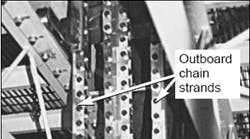What makes rigid chain work is its link shape. The links lock in compressive load but, when retracted, they let the chain coil up like regular transmission roller chain. There are many chain-return styles, allowing several options in design envelope. Also, the chain supplier offers several sprocket drive options.
What Westinghouse came up with was, in effect, two vertical rigid chains back to back. The chains create a column, rigid under its own weight, that can reach 16 ft up under a BWR, grab the 1,000-lb fuel rod assembly at its bottom with hookup help from a worker, and gently lower it within a vertical framework by means of an air-powered gearmotor. As the chain column lowers, it runs through a double sprocket assembly that separates the two strands and lets them coil up in a 180-deg turn. The whole system of chains, sprocket drive, and fuel rod assembly becomes part of the structure, and the weight of it all hangs from the two outboard ends of the chains.
The sprocket drive rides up and down beneath the rod assembly. It travels at half the vertical speed of the rod assembly, because the sprocket-and-chain system of each half is like an inverted simple rope block and tackle with two strands or falls of rope — the block moves at half the speed of the movable strand. The rod assembly moves at about 4 ips. When it is fully withdrawn, the structure is tipped into the horizontal plane to prepare the rod assembly for removal from the site.
The chain supplier also furnishes the sprocket drive, in this case a 10:1 reduction double-enveloping wormgear drive. It connects by means of a transmission roller chain drive to an air gearmotor furnished by Westinghouse.
Six systems have been supplied to Westinghouse.
Rigid chain systems described in this article are by Serapid U.S.A. Inc., Troy, Mich.
